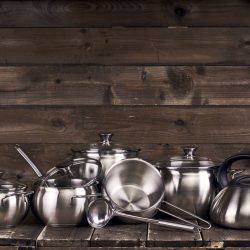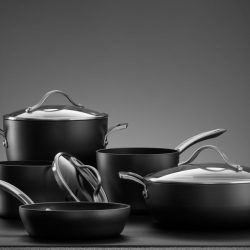 When you want to grab the right bowl for your grandmother’s recipe, you might wonder if you can put tomato sauce into a stainless steel bowl. We’ve researched how stainless steel is made and whether it interacts with your food to get the answer.
When you want to grab the right bowl for your grandmother’s recipe, you might wonder if you can put tomato sauce into a stainless steel bowl. We’ve researched how stainless steel is made and whether it interacts with your food to get the answer.
Stainless steel is a non-reactive metal, an excellent choice for both cooking and storing tomato sauce, or other acidic foods. Bowls and cookware made from stainless steel will not alter the flavor of your foods and will not stain because of interacting with foods like tomatoes, citrus, eggs, and vinegar.
Keep reading, and we will explain why stainless steel is perfect for use in your kitchen for not only bowls but also appliances, pots, and cutlery.
What Are Stainless Steel Bowls Made Of?
The bowl in your kitchen is most likely made from stainless steel, an iron, and chromium alloy, with additives used to enhance the quality of the steel.
Click here to find this on Amazon.
How is Stainless Steel Made?
Before a sheet of stainless steel can become a bowl, it takes four steps to make the steel:
- Melting - Did you know stainless steel is 100% recyclable? Scraps can start the process of melting; temperatures will vary based on what qualities are sought for the final product.
- Extract Carbon - Adjusting the amount of carbon is a chemically controlled process; carbon content alters the strength of the stainless steel.
- Fine Tuning - Preparing the steel for various uses, fine-tuning the composition of the steel is done by temperature and chemical alterations.
- Shaping (or Casting) - The final product will be shaped into a slab, rod, or other form depending on the intended use.
What Grade of Stainless Steel is Used for Bowls?
Depending on the composition of the steel, they can produce it for several different uses. The quality of steel is referred to by both a number, for composition, and a grade, for durability.
The stainless steel used to make bowls has an 18/8 composition and is a 304 grade of steel. The number indicates that this type of stainless steel is composed of 18% chromium and 8% nickel additives. It is the most commonly used type of stainless steel for kitchen appliances, cookware, and utensils.
There are slight variations of the composition among 304-grade steel. Still, common qualities such as anti-corrosiveness, resistant to extreme heat or cold, and improved strength can be found throughout this grade.
Are Stainless Steel Bowls Safe?
Absolutely! Stainless steel bowls are made from food-grade steel. It is widely used for consumer products, such as kitchenware, because it is durable, corrosion-resistant, and has an aesthetically pleasing finish.
The Food and Drug Administration (FDA), the American National Standards Institute (ANSI), and the National Science Foundation (NSF) all collaborate to regulate the composition of Food Contact Substances (FCS), including stainless steel. Manufactures using stainless steel for any product that will come into direct contact with food must guarantee it meets FDA, ANSI, and NSF requirements of a minimum of 16% chromium content.
Stainless steel of less than 16% chromium content can be used for the production of blades on cutlery and appliances. But, all of your mixing bowls, storage containers, and pots will be made from 18/8 stainless steel.
Does Stainless Steel React with Food?
As a non-reactive metal, stainless steel will not transfer any chemicals to your food or beverages. It also does not alter the flavors of your favorite foods, which makes stainless steel a great choice of material for mixing bowls, serving bowls, food storage containers, and pots.
What is Reactive Metal Cookware?
Cookware made from aluminum, cast iron, carbon steel, and copper is reactive. These metals can leech trace amounts of aluminum, iron, and copper into our food. As a result, the flavor and color of the food can be altered. Some say the food tastes metallic. Acidic foods like tomatoes, vinegar, and citrus are the most susceptible.
Reactive cookware is also prone to staining, from interactions with acidic and sulfuric foods. So, it can require more maintenance than stainless steel cookware to keep it looking like new.
Metal cookware is typically treated to prevent reactivity with our food:
- Aluminum is anodized or coated with non-stick or enamel to reduce reactivity.
- Carbon steel cookware must be routinely seasoned to reduce reactivity, especially after having cooked acidic foods.
- Cast iron that is routinely seasoned will be less reactive to acidic foods. Some cast iron cookware is coated with enamel for non-stick and non-reactivity qualities.
- Copper pans are frequently lined with tin, a non-reactive metal that will not prohibit copper’s high conductivity.
Are There Benefits to Using Reactive Cookware?
Reactive metals are:
- Durable.
- Lightweight.
- Unbreakable.
- Good conductors of heat.
- Easy to clean.
Pots, pans, and bakeware made of aluminum, cast iron, carbon steel, and copper will be a long-lasting addition to your kitchen’s cookware.
Can You Cook Tomato Sauce in Stainless Steel?
Because stainless steel is a non-reactive metal, it is recommended by food experts and chefs alike to use for cooking tomato sauce and other recipes that use acidic foods like salsas, dressings, and sauces.
Mix up any recipe by selecting stainless steel bowls in a variety of sizes, for easy nesting storage.
Click here to find this bowl set on Amazon.
Is it Safe to Store Food in Stainless Steel Bowls?
You can safely store both raw and cooked foods in stainless steel bowls, or other types of stainless steel containers. Because stainless steel does not exude chemicals into your food, it will be safe for as long as the food remains fresh to eat. Plus, metal storage containers are eco friendly because stainless steel is a recyclable material.
Click here to find these storage bowls on Amazon.
Stainless steel is an affordable material that provides long-lasting, versatile cookware for your kitchen. Your stainless steel bowls can be used for mixing, storing, serving, and cooking food time and time again.








![Clean copper sauce pans and mixing bowls hanged on a restaurant wall, How To Clean A Copper Mixing Bowl [4 Effective Ways]](https://kitchenseer.com/wp-content/uploads/2020/11/Clean-copper-sauce-pans-and-mixing-bowls-hanged-on-a-restaurant-wall-250x250.jpg)
